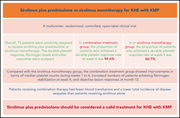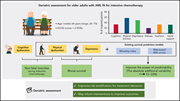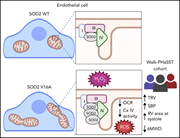Issue Archive
Table of Contents
BLOOD COMMENTARIES
PLENARY PAPER
Sirolimus plus prednisolone vs sirolimus monotherapy for kaposiform hemangioendothelioma: a randomized clinical trial
Clinical Trials & Observations
Kaposiform hemagioendothelioma (KHE) is a rare, pediatric vascular neoplasm frequently associated with thrombocytopenia and consumptive coagulopathy, termed Kasabach-Merritt phenomenon (KMP), predicting a poor prognosis. In this Plenary paper, Ji and colleagues present results of a trial of 73 patients with KHE randomized to sirolimus plus or minus prednisolone for the treatment of KFE/ KMP, indicating that patients receiving combined therapy have markedly improved platelet and tumor responses.
PERSPECTIVE
Is it time for PET-guided therapy in follicular lymphoma?
In this timely Perspective, Trotman and Pettitt discuss the role of FDG-PET in the management of follicular lymphoma. They review its role in diagnosis, for end-of-induction assessment of response and follow-up post-remission. They outline the path forward for integrating PET into treatment decision-making to more effectively treat patients with poor prognosis and to consider limiting therapy in patients with good prognosis at risk of being overtreated.
BLOOD SPOTLIGHT
Three US Food and Drug Administration–approved therapies for chronic GVHD
Chronic graft-versus-host disease (cGVHD) is the major complication of allogeneic stem cell transplantation, and effective therapies are limited. In this Blood Spotlight, Zeiser and Lee review three drugs that have been approved by the FDA in the past 4 years: ibrutinib, belumosudil, and ruxolitinib. They summarize the development and clinical testing of these drugs and discuss their role in the treatment of cGVHD.
CLINICAL TRIALS AND OBSERVATIONS
Geriatric assessment predicts nonfatal toxicities and survival for intensively treated older adults with AML
CME
Clinical Trials & Observations
Older adults with acute myeloid leukemia (AML) have worse outcomes than their younger counterparts, and the impact of geriatric assessment in predicting outcomes is controversial. In this month's CME article, Min et al report on extended geriatric assessment in over 100 older patients with AML, demonstrating that assessment of physical function, depression, and cognitive impairment may improve survival prediction.
HEMATOPOIESIS AND STEM CELLS
Genome-wide association study on 13 167 individuals identifies regulators of blood CD34+cell levels
IMMUNOBIOLOGY AND IMMUNOTHERAPY
Donor memory-like NK cells persist and induce remissions in pediatric patients with relapsed AML after transplant
Clinical Trials & Observations
The prognosis of relapsed acute myeloid leukemia (AML) following allogeneic stem cell transplant is very poor, and salvage chemotherapy and donor lymphocyte infusion (DLI) are rarely curative. Previous studies suggest that ex vivo cytokine-stimulated natural killer (NK) cells become memory-like (ML) NK cells with enhanced anti-leukemia activity. Bednarski and colleagues report promising Phase 1 results in 9 pediatric/young adult patients treated with DLI and donor ML NK cells, suggesting a novel treatment approach for relapsed AML following allogeneic transplant that should be further explored.
LYMPHOID NEOPLASIA
Validation of POD24 as a robust early clinical end point of poor survival in FL from 5225 patients on 13 clinical trials
Clinical Trials & Observations
Patients with follicular lymphoma (FL) who progress within 24 months of front-line therapy (POD24) have poor outcomes, but clinical factors predicting early relapse are not established. Casulo et al analyzed pooled data from 13 clinical trials and validated POD24 as a predictor of poor prognosis and identified male gender, unfavorable performance status, elevated β-2 microglobulin, and high FLIPI score as baseline predictors of POD24, laying the groundwork for the development of better predictive models at diagnosis to guide therapy.
MYELOID NEOPLASIA
Conditioning intensity and peritransplant flow cytometric MRD dynamics in adult AML
Clinical Trials & Observations
PHAGOCYTES, GRANULOCYTES, AND MYELOPOIESIS
Heightened turnover and failed maturation of monocyte-derived macrophages in murine chronic granulomatous disease
Chronic granulomatous disease (CGD) results from loss of NADPH oxidase and is associated with altered phagocyte function and exaggerated inflammation. Gibbings et al demonstrate that monocyte-derived macrophages (MoMacs) from CGD mice are recruited normally following peritoneal zymogen injection but fail to mature, maintaining an inflammatory phenotype and forming pyrogranulomata. Interestingly, this is not cell-intrinsic but appears to be driven by the milieu, as CGD MoMacs transferred into inflamed peritoneum of wildtype mice mature normally.
THROMBOSIS AND HEMOSTASIS
Platelet ACKR3/CXCR7 favors antiplatelet lipids over an atherothrombotic lipidome and regulates thromboinflammation
TRANSPLANTATION
A CD45-targeted antibody-drug conjugate successfully conditions for allogeneic hematopoietic stem cell transplantation in mice
VASCULAR BIOLOGY
SOD2 V16A amplifies vascular dysfunction in sickle cell patients by curtailing mitochondria complex IV activity
Brief Report
Dosunmu-Ogunbi and colleagues report that a common genetic variant in mitochondrial superoxide dismutase 2 (SOD2) is associated with increased cardiac dysfunction in patients with sickle cell disease (SCD). This SOD2 variant increases production of reactive oxygen species leading to increased oxidant stress. This could be an important biomarker indicating predilection to cardiovascular dysfunction in patients with SCD.
LETTER TO BLOOD
BLOOD WORK
ERRATA
CONTINUING MEDICAL EDUCATION (CME) QUESTIONS
-
Cover Image
Cover Image
![issue cover]()
Immunofluorescence staining of a pyogranuloma at the diaphragm following zymosan-induced peritonitis in murine chronic granulomatous disease. Heightened numbers of recruited monocyte-derived macrophages (F4/80, red) surround neutrophils (nuclei, blue) within a fibrin mesh (green). See the article by Gibbings et al on page 1707.
- PDF Icon Front MatterFront Matter
- PDF Icon Table of ContentsTable of Contents
- PDF Icon Editorial BoardEditorial Board
Advertisement intended for health care professionals
Email alerts
Advertisement intended for health care professionals














Targeting inflammation-induced Kasabach-Merritt phenomenon
Clinical Trials & Observations